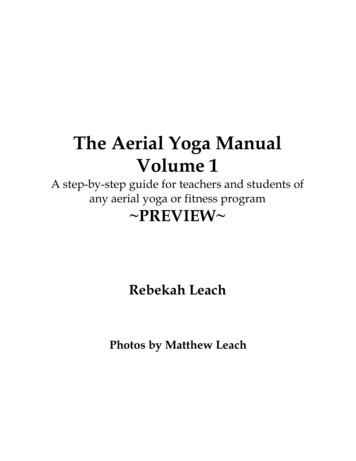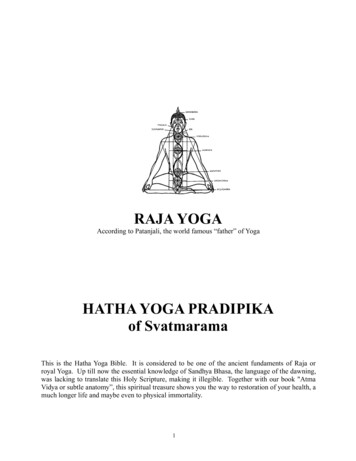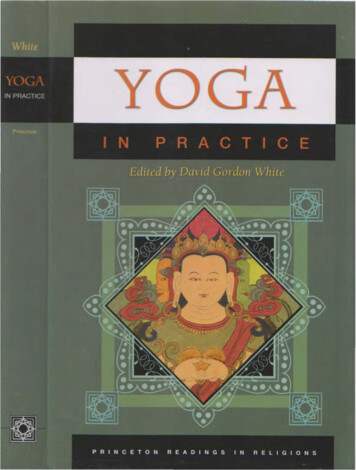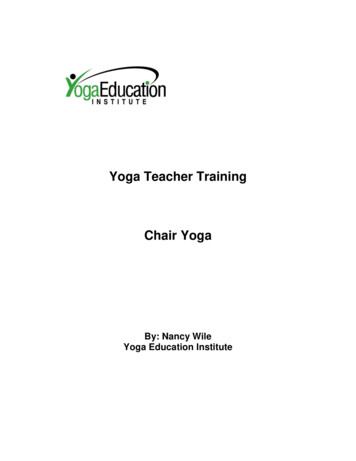
Transcription
The Aerial Yoga ManualVolume 1A step-by-step guide for teachers and students ofany aerial yoga or fitness program PREVIEW Rebekah LeachPhotos by Matthew Leach
All rights reserved.First edition was published in 2009No part of this publication may be reproduced, stored in a retrieval system, or transmitted in any way orby any means, electronic, mechanical, photocopying, recording or otherwise, without the prior writtenpermission of Rebekah Leach.This book may be purchased with bulk discounts. Please send an e-mail to aerial.dancing@yahoo.comfor more information or visit AerialDancing.com.When practicing any aerial fitness program, always do so in the presence of a trained professional, withload-tested fabric hanging from load-tested rigging, which has been set-up and is inspected frequentlyby rigging professionals, along with crash pads underneath the fabric. It is recommended that you checkwith your doctor or healthcare provider before commencing any exercise especially a rigorous programthat includes inversions such as aerial yoga.Whilst every care has been taken in the preparation of this material, there is a real chance of injury inexecution of the movements described in this book. The Publishers and all persons involved in themaking of this manual will not accept responsibility for injury to any degree, including death, to anyperson as a result of participation in the activities described in this manual. Purchase or use of thisdocument constitutes agreement to this effect. Furthermore, rigging of aerial equipment is not discussedin this manual. It is highly recommended that you consult a professional rigger when it comes to the useof any hanging equipment.ISBN 978-0-557-28838-0Third EditionPublished by Rebekah LeachCopyright 2011Rebekah Leach
PrefaceFor the past three years, I have been watching the worldwide birth, growth and sequentialrapid spread of aerial yoga with fascination. My own aerial yoga story began in 2007. I hadjust moved to Ojai, CA, a hidden treasure of a town, where it’s rare to find a resident whodoesn’t do yoga. At that point in time, I was intensely immersed in the aerial arts, with alarge emphasis on fabric. For the purpose of introducing students to work in the air, I wasworking on aerial fabric with a low tied in it. Having a loop provided a way for students towork in tandem with the ground and fabric simultaneously , so that students could learnhow an apparatus can take your weight, and then how this can be used for stretching,building strength, and ultimately for dance and other flow movement.Putting these two factors together meant that I had an abnormal amount of students whopractice yoga on a regular basis, Many people would make comments on the movementssuch as, “oh – this is just pigeon only upside-down” (in reference to a move that aerialiststypically call gazelle). And other movements .So, in my surroundings, naturally I beganthinking more and more about this concept of combining aerial with yoga.Then a little light bulb went off in my head that said, this seems like such a natural progression, Ibet there are others out there undertaking the exact same thing. Living on the edge of a nationalforest was not the best place for an internet connection, but one day I eagerly waited out theloading of the pages to see what would come up when I typed “aerial yoga” into Google.When compared to today, I am amazed to think back on that memory of only finding onearticle and one person and one picture. I figured that there were others out there, but theyjust hadn’t made their way into cyberspace yet.It remained a small, growing thought at the back of my mind, “what would it look like tocombine aerial with yoga?” But it was still another year before I took action. Fast forward tothe summer of 2008 – the Aerial Dance Festival held annually in Boulder, CO was offering anaerial yoga class! The apparatus of choice: trapeze. This is going to be interesting, I thought,what can do you with yoga and a trapeze? While my apparatus of choice remains to his dayaerial fabric , the class gave me the spark I needed to start creating a curriculum and then,open up classes for aerial yoga.There’s a lot that happened in between then and now which is a story for another time. Itsuffices to say that I suddenly found myself with the freedom to spend time working onperfecting an aerial yoga curriculum while producing this manual and the videos that gowith it. My curriculum has grown and evolved, and taken shape. I like it more and more allthe time! I must confess, I have not always liked my work-in-progress curriculum but I knewI had to start somewhere especially because at the time, there was no one else to dialoguewith, bounce ideas around, etc.
One might say that I created the moves in this book, but I would not agree. I feel that it was ajob in translation. It was about taking a look at a yoga move and asking the question, “Inwhat ways can the fabric support the body in that position?” The fabric mirrors many of thetools that have already been in place for yogis such as the use of a strap. The process felt verysystematic. Once I created the categories that I describe in the introduction, moves just fellinto place. Now, I will say I “discovered” these moves. This just means that no one taughtthem to me and I got the privilege of being an explorer, but I do not think that these movesare unique to my body. Granted, it may take a while before someone else comes to the samecrazy moves, but in general, it does not at all surprise me when I see similar basic moves inan aerial yoga class that has no connection to me. “Bodies in motion will find similarmovement” and this is a classic example of that quote in action.Just as I wrote in my aerial fabric manual series, I believe it’s important to honor the pioneersof a new art form, but I hope that we can have a collaborative spirit in the growth of aerialyoga just as in any other movement form and not get caught up with a move “belonging” tosomeone. Choreography belongs to someone. Moves do not. Sometimes, it’s hard to tell thedifference. Applying this here, pioneers are honored by you giving credit that you wereinspired by them, you learned new things from them, and you can complete the circle byacknowledging their influence upon your own work. It remains that the movement itselfdoes not belong to them. It belongs to the people.Please don’t misunderstand what I am saying – all rules of copyright, etc. still apply! But, as Iwatched the growth of aerial yoga, I have witnessed an amazing thing – multiple peoplecoming to the same conclusions at the same time. Each pioneer has led with their own style,created some left-field moves that are unique to them, made different choices about what tocall aerial yoga, how to divide the line between aerial arts and aerial yoga, and are nowmaking choices about how to lead the next generation. When you type “aerial yoga” intoGoogle, you no longer have just one result* – you have a multitude and I’m glad that amongthat multitude, you and I have come together to move this movement forward.Happy Flying,Rebekah*Granted, at the time of this writing, this aerial yoga manual series remains to be the first and onlybook written on aerial yoga. I mean multitude by way of everything surrounding aerial yoga. Itwouldn’t surprise me if, in the coming decade, aerial yoga became as ubiquitous as yoga itself.
Sitting on the loop ABOUT THIS MOVEPrerequisite: noneIf you have ever swung on aswing, then there is not a lot ofnew information here. Although,you’d be surprised at how longsome adults have gone without aswing at the park. It brings outthe playfulness in us, and that isone of the best qualities of aerialyoga—it lightens the spiritwhich opens the door to restingwell. While the initial concept issimple, there are some balancingexercises that are harder thanthey first appear.There are two main ways to get into sitting onthe loop. One is from the front, like getting on aswing at the park, and one is from the back,putting in one leg at a time. Since most peopleare familiar with a swing, they are tempted totreat the fabric just like a swing and then whathappens is that they pull up and miss gettingtheir buttocks over the loop. This happensbecause they misjudged the quality of thefabric. It is soft and light and can easily stick toyour body. A swing at the park is heavy andwhen you lift up, it generally stays put. Not sowith the looped fabric. Now, this does dependon how high the fabric is set. If the loop is low,then there is no problem, but if the loop ishigher, you’d be surprised by the difficulty itposes to some people. In effort to bring aerialyoga to the people, I like to offer the followingmethod as an alternative if the fabric is too highto comfortably get into like a swing. This alsoallows for a first lesson in hanging from theshoulders in neutral position.1Put one leg through the looped fabric.Bend the standing leg and begin takingweight in your hands. Keep yourshoulders “seated” in your back. Do not letyour shoulders come up as you take weight inyour grip. It can be tempting to bend yourarms, but see if you can keep them straight.Note: this is our first opportunity to apply thelessons of neutrality talked about in theintroduction. The shoulders are to be pulled intotheir neutral position in the back with the armsslightly forward.2Hold on with both hands to the fabric asyou bring your other leg into the loop.Again, keep those shoulders in mind.You can imagine a large air bubble heldbetween the base of the neck and the shouldersthat you don’t want to pop.
3Come up to a seated position. If you canreach the floor with your toes, feel free topush off and give yourself a swing.Exit StrategyHold on to both sides of thefabric. Lift your weight sothat you can step forwardonto the ground, just as youwould exit a swing.ProgressionWhile sitting on the loop, carefully remove your hands from the fabric for abalance. To make the balance more challenging, close your eyes. To make itExit Strategyeven more challenging, swing while doing this. To make it even moreHold onto both sidesoftothechallenging,flipthe flying staff pose to read more about the process offabric. Liftyourweightso legs in this position.straightening yourthat you can step forwardonto theground,as youCathyGauch,justof AircatAerial Arts discovered the challenges ofwith your eyes closed while recovering from a brainwould balancingexit a swing.injury that she received from a car crash in 2009. As a teacher ofaerial yoga, she has much insight into the way the brain interactswith airborne movement as she went through the recoveringprocess. She never gave up at coming back to her love of the aerialarts; she has simply found new ways to challenge herself. Rest
Reverse Straddle Prerequisite: none1Put your arms through the fabric as ifyou were getting on a swing, but onlyput your arms through. Situate yourselfso that the fabric is at your back, supportingyour ribs with the looped fabric. Extend yourlegs in front of you so that you are nowleaning your weight into the loop. Hold thefabric with bent arms, elbows at your sides.3Once you have the fabric comfortablypositioned on the pelvic bone, openyour legs outward. Warning: DO NOTPUT YOUR LEGS THROUGH THE LOOP!Use your lower abdominal muscles to helprotate the pelvic girdle so that the knees stayfacing the ground.42Think of pulling up and at the same timepushing your hands toward your toes asyou engage your abdominal muscles topull the legs up. It helps to bend your kneeswhen you first start. As you raise your legs,keep them open, making sure that they passon the outside of the fabric as you rotate back.(Optional Step) This step is applicable ifthe loop is still around your stomachrather than your hips. The reversestraddle will not be comfortable until you findjust the right position of the fabric aroundyour hips.A) Place your legs against the outside of thefabric while sickling your feet so that your toespull in to meet each other.
Relaxation Pose Prerequisite: noneThis move is likened to the corpse pose lying on the floor from traditional yoga, but don’t let that trick you intothinking that they are the same pose. The hammock does not give support to your bones in the same way that thefloor does. So do not think of this pose as a “replacement” for the traditional corpse pose. Rather, enjoy each inits own way.1Spread out the loop into a hammockand sit on about half of the material.Open the fabric with your arms andmake sure that the fabric covers yourshoulders with enough extra for your head. 23Stretch your legs by bringing one leg ata time toward your nose. Hold on toyour leg as you straighten it and thenrelease it. Continue to press with the oppositeleg into the fabric.Holding your excess fabric above yourhead, lay back into your hammock. Useyour feet to open up the rest of thefabric so that your entire body is lying inside.Adjust so that you are comfortable.
rapid spread of aerial yoga with fascination. My own aerial yoga story began in 2007. I had just moved to Ojai, CA, a hidden treasure of a town, where it's rare to find a resident who doesn't do yoga. At that point in time, I was intensely immersed in the aerial arts, with a large emphasis on fabric.










